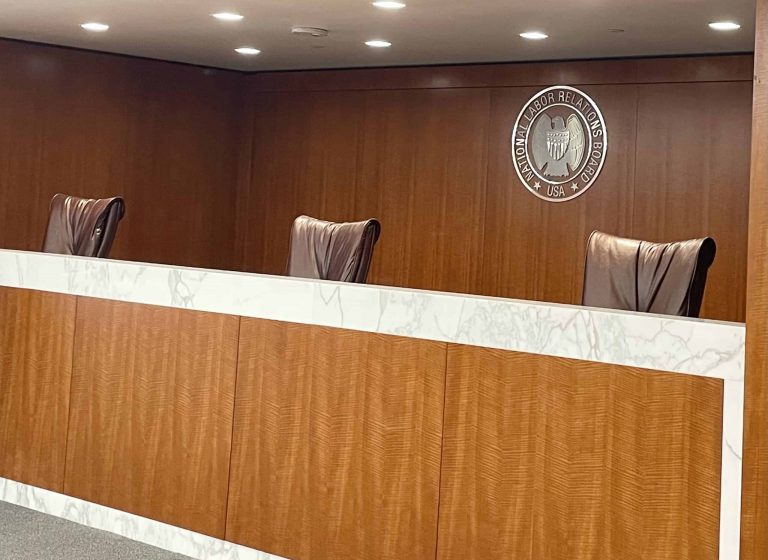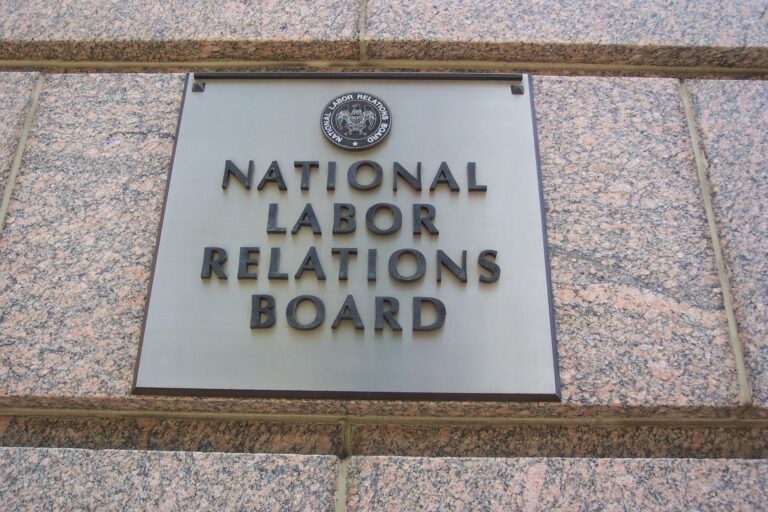
Tiran Bajgiran is a student at Harvard Law School.
In 2021, Amazon spent $4.3 million on union-busting, paying labor-consulting firms $3,200 a day to suppress worker power. Per diem, UPS spent $2,625 to prevent drivers from organizing. The Labor Relations Institute, a labor-management firm, received over $1 million to thwart unionization efforts by truck drivers at Cemex, a concrete-distribution company.
We know figures like these only because of filings required by the Labor-Management Reporting and Disclosure Act (LMRDA), under the auspices of the federal Department of Labor (DOL). These mandatory forms disclose the relationship between companies and the consultants they engage for labor management, including the amounts the companies paid for their services. By law, LM‑20s have to be filed by consultants — usually, people who work for labor-management firms — within 30 days after they are hired, with their names and the terms under which they were engaged. Employers, in turn, must file their LM-10s within 90 days after the close of their fiscal year. These forms reveal who the consultants are and how much the companies pay them.
The information in LM-10s and LM-20s is thus a crucial tool in workers’ fights against corporations like Amazon and UPS, a necessity for effective mobilization.
Yet the available data are only the tip of the iceberg — and far from accurate.
1. Loopholes & Non-Compliance
A new report from the LaborLab, analyzing years of DOL filings, concluded that the number of LM-10 and LM-20 forms filed have fallen to their lowest rate in a decade. Between 2010 and 2017, the number of LM-20s filed rose from 446 to 753, DOL data showed. But then it drastically fell again after 2017, down to just 314 in 2021. LM-10s filings have also been steadily falling — from 1,000 in 2010 to 403 in 2021.
More significantly, 82 percent of anti-union consultants did not file the LM-20s by the 30-day deadline in 2021, according to the LaborLab’s analysis. Consultants are also supposed to attach any written agreements they have with the companies that hire them, but only around one-quarter did. And over half did not report how much they were compensated.
Employers who hire these third-party consultants are just as non-compliant. LaborLab’s analysis of LM-10s filed in 2021 found that $26 million was reportedly spent by companies to hire consultants. But nearly 90 employers have still not filed the LM-10 for that year, even though it should have been done by March of this year. The total amount spent on suppressing unionization efforts, then, could end up being much higher; an Economic Policy Institute report found that, between 2014 and 2018, an estimated $340 million a year was paid to union suppression consultants.
But even if filed timely, the reported data are far from comprehensive; employers are required to document their dealings only with consultants who communicate directly with employees — a broad exemption that shields a workforce’s awareness of avoidance messaging when it is relayed to them solely by their bosses. Hence why, for instance, the public is unaware of how much Starbucks is actually spending on union-suppressing activity; their consultants — the law firm, Littler Mendelson — have been hired to strategize for and counsel an elaborate anti-union campaign, but the firm’s attorneys do not meet with workers directly, so Starbucks does not have to report how much it spends to suppress worker organizing.
2. Impunity
Another compounding factor is the lack of punitive measures. While a false report or “willful failure to file a required report” can result in criminal charges, the LMRDA does not impose monetary penalties on delinquent filers, and OLMS must file a case with a U.S. district court to force a recalcitrant employer or consultant to submit the forms.
Given the number of companies and consultants engaged in union suppression, the DOL may be too busy to go after every violation. Funding for OLMS has been flat the past 16 years at around the $40 million to $45 million mark. Indeed, OLMS got more funding in 2006 — $45.7 million — than in 2022, when it received $44.4 million from the federal budget.
Incomplete names, lack of any payment details, office addresses that are UPS mailboxes, and simply a lack of any information are common in OLMS filings, and often add up to a failure to reveal the extent of anti-union activities.
OLMS Director Jeff Freund acknowledged in a blog post in January the “significant under-reporting” and claimed that the agency was “taking steps to end this chronic non-compliance,” including reviving a program to remind employers and consultants to make their filings.
Getting these forms filed on time is all the more crucial today as a wave of unionization spreads across the United States. The Bureau of Labor Statistics’ figures showed that union membership has been falling over decades, and only 6.1 percent of private-sector employees were unionized in 2021, down from 16.8 percent in 1983.
3. Organizing for Countervailing Worker Power
Many reforms have been advanced to enhance filing requirements and prevent illegal union suppression.
In 2016, the Obama Administration promulgated the persuader regulation to make LM 10s and LM 20s more effective. The 2016 rulemaking would have closed a loophole in federal disclosure regulations that exempt businesses from filing publicly accessible financial reports detailing their hiring of third-party labor relations advisers. However, the regulation got tied up in litigation, and then the Trump Administration rescinded it. Now, the Biden DOL is mulling a return to the Obama-era regulation that would give the public unprecedented transparency into employers’ reliance on outside consultants and attorneys to help them oppose union organizing drives. Congressional Democrats hope to codify it into law as part of the Protecting the Right to Organize Act, a sweeping bill to overhaul labor law that faces long odds in the Senate but has been endorsed by the Biden administration.
Another solution, as Terri Gerstein, director of the State and Local Enforcement Project at the Harvard Labor and Worklife Program, has pointed out, is a DOL rule that could stop companies from using federal funds to hire consultants, or a requirement that companies disclose their labor-management activities much earlier.
In a similar vein, the No Tax Breaks for Union Busting Act would end the taxpayer subsidization of anti-union activity by corporations. The bill would classify businesses’ interference in worker-organization campaigns like political speech under the tax code and therefore not tax deductible. The bill would also establish an IRS reporting requirement for employers who intervene in protected labor activities.
Alternatively, employers could redirect the funds they spend on union suppression into bettering workplace conditions and treating their employees fairly. What if, instead of paying millions to union-busting consultants, companies raised worker salaries, gave them decent health care, and invested in safe and healthy workplaces?
A first step for advocacy in that direction is accurate information. And for that, we need robustly enforced and comprehensive filing requirements to grasp the scale of the labor-consultancy industry.









Daily News & Commentary
Start your day with our roundup of the latest labor developments. See all
July 7
LA economy deals with fallout from ICE raids; a new appeal challenges the NCAA antitrust settlement; and the EPA places dissenting employees on leave.
July 6
Municipal workers in Philadelphia continue to strike; Zohran Mamdani collects union endorsements; UFCW grocery workers in California and Colorado reach tentative agreements.
July 4
The DOL scraps a Biden-era proposed rule to end subminimum wages for disabled workers; millions will lose access to Medicaid and SNAP due to new proof of work requirements; and states step up in the noncompete policy space.
July 3
California compromises with unions on housing; 11th Circuit rules against transgender teacher; Harvard removes hundreds from grad student union.
July 2
Block, Nanda, and Nayak argue that the NLRA is under attack, harming democracy; the EEOC files a motion to dismiss a lawsuit brought by former EEOC Commissioner Jocelyn Samuels; and SEIU Local 1000 strikes an agreement with the State of California to delay the state's return-to-office executive order for state workers.
July 1
In today’s news and commentary, the Department of Labor proposes to roll back minimum wage and overtime protections for home care workers, a federal judge dismissed a lawsuit by public defenders over a union’s Gaza statements, and Philadelphia’s largest municipal union is on strike for first time in nearly 40 years. On Monday, the U.S. […]